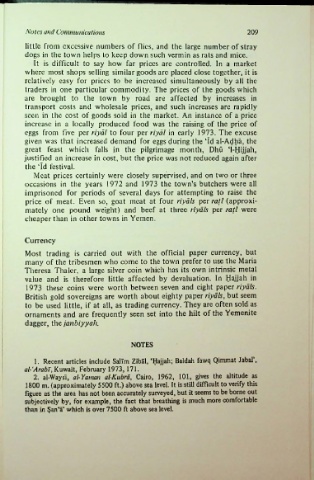Page 217 - Arabian Studies (II)
P. 217
Notes and Communications 209
little from excessive numbers of flies, and the large number of stray
dogs in the town helps to keep down such vermin as rats and mice.
It is difficult to say how far prices are controlled. In a market
where most shops selling similar goods arc placed close together, it is
relatively easy for prices to be increased simultaneously by all the
traders in one particular commodity. The prices of the goods which
are brought to the town by road are affected by increases in
transport costs and wholesale prices, and such increases arc rapidly
seen in the cost of goods sold in the market. An instance of a price
increase in a locally produced food was the raising of the price of
eggs from five per riyal to four per riydl in early 1973. The excuse
given was that increased demand for eggs during the ‘Id al-Adha, the
great feast which falls in the pilgrimage month, Dhu ‘1-Hijjah,
justified an increase in cost, but the price was not reduced again after
the ‘Id festival.
Meat prices certainly were closely supervised, and on two or three
occasions in the years 1972 and 1973 the town’s butchers were all
imprisoned for periods of several days for attempting to raise the
price of meat. Even so, goat meat at four riyals per rati (approxi
mately one pound weight) and beef at three riyals per rati were
cheaper than in other towns in Yemen.
Currency
Most trading is carried out with the official paper currency, but
many of the tribesmen who come to the town prefer to use the Maria
Theresa Thaler, a large silver coin which has its own intrinsic metal
value and is therefore little affected by devaluation. In Hajjah in
1973 these coins were worth between seven and eight paper riyals.
British gold sovereigns are worth about eighty paper riyals, but seem
to be used little, if at all, as trading currency. They are often sold as
ornaments and are frequently seen set into the hilt of the Yemenite
dagger, the janbiyyah.
NOTES
1. Recent articles include Salim Zibal, 'Hajjah; Baldah fawq Qimmat Jabal’,
al-'ArabT, Kuwait, February 1973, 171.
2. al-Waysl, al-Yaman al-Kubrd, Cairo, 1962, 101, gives the altitude as
1800 m. (approximately 5500 ft.) above sea level. It is still difficult to verify this
Figure as the area has not been accurately surveyed, but it seems to be borne out
subjectively by, for example, the fact that breathing is much more comfortable
than in §an‘a’ which is over 7500 ft above sea level.

